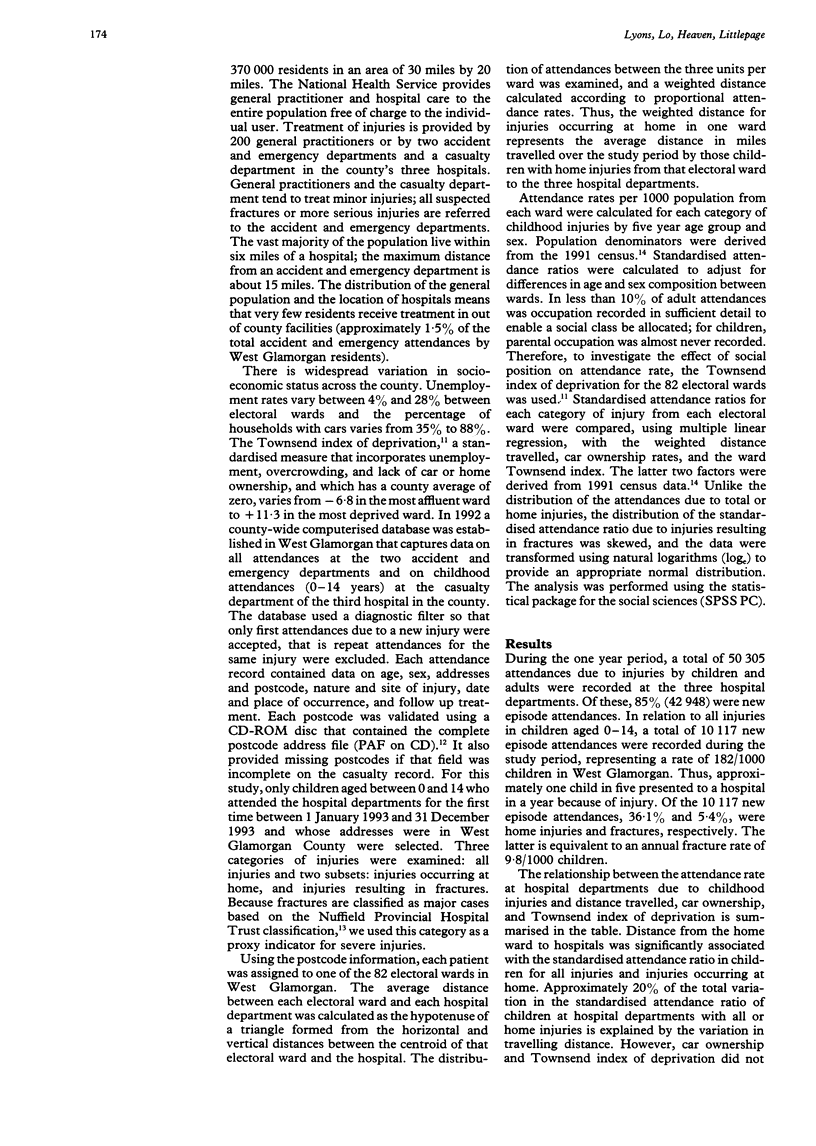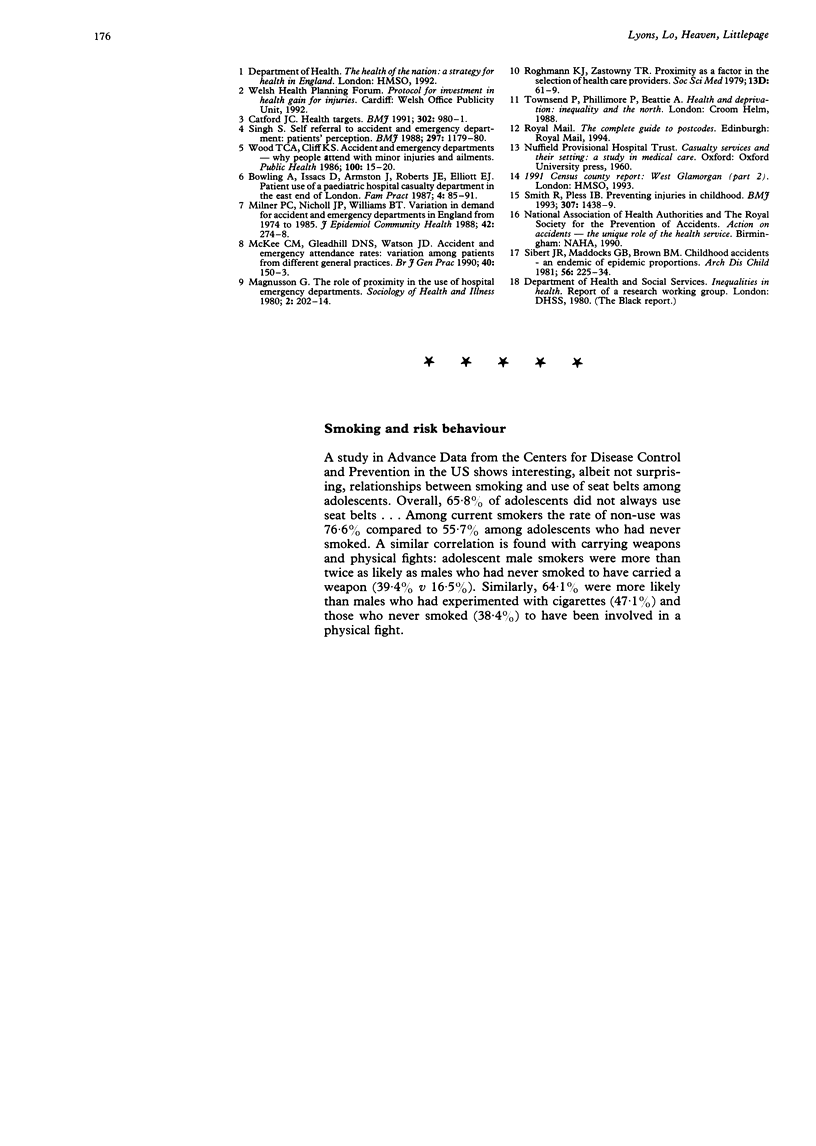Abstract
OBJECTIVE: To assess the usefulness of a centralised injury database in monitoring progress towards nationally set health targets for the reduction of childhood injuries. SETTING: West Glamorgan County, Wales. METHODS: Analysis was undertaken of data held in the West Glamorgan injury database which amalgamates population data with data from the three hospital units covering a population of 370,000. All first attendances due to a new injury in children aged 0-14 occurring in 1993 were analysed, with subgroup analysis for injuries occurring in the home and injuries resulting in fractures. Standardised injury ratios were compared with the distance travelled, car ownership, and Townsend index of deprivation at the ward level, using multiple linear regression. RESULTS: A total of 10,117 first time visits due to injuries were recorded, representing a rate of 182 injuries/1000 children aged 0-14 in West Glamorgan County. Distance from home to the accident and emergency departments was inversely correlated with total injury attendances, and injuries occurring at home, but not with injuries resulting in fractures. Visit rates for any type of injury were not associated with local car ownership rates or deprivation indices. CONCLUSIONS: Proximity to accident and emergency departments is a strong determinant of the use of the service by children with overall injuries, and injuries occurring at home. The lack of a significant association between travel distance and injuries resulting in fractures suggests that it is more meaningful to use a centralised database of accident and emergency department attendances to monitor the more severe spectrum of childhood injuries in assessing progress towards national targets for their reduction. The absence of an association between severe injuries and local socioeconomic factors suggests that national targets for the reduction of socioeconomic differentials in childhood injuries may need to be reassessed. These databases are also useful in generating information to direct preventive strategies and to target resources to areas of greatest need.
Full text
PDF



Selected References
These references are in PubMed. This may not be the complete list of references from this article.
- Bowling A., Isaacs D., Armston J., Roberts J. E., Elliott E. J. Patient use of a paediatric hospital casualty department in the east end of London. Fam Pract. 1987 Jun;4(2):85–90. doi: 10.1093/fampra/4.2.85. [DOI] [PubMed] [Google Scholar]
- Catford J. C. Health targets. BMJ. 1991 Apr 27;302(6783):980–981. doi: 10.1136/bmj.302.6783.980. [DOI] [PMC free article] [PubMed] [Google Scholar]
- Evans L. Medical accidents: no such thing? BMJ. 1993 Dec 4;307(6917):1438–1439. doi: 10.1136/bmj.307.6917.1438. [DOI] [PMC free article] [PubMed] [Google Scholar]
- Magnusson G. The role of proximity in the use of hospital emergency departments. Sociol Health Illn. 1980 Jul;2(2):202–214. doi: 10.1111/1467-9566.ep10487794. [DOI] [PubMed] [Google Scholar]
- McKee C. M., Gleadhill D. N., Watson J. D. Accident and emergency attendance rates: variation among patients from different general practices. Br J Gen Pract. 1990 Apr;40(333):150–153. [PMC free article] [PubMed] [Google Scholar]
- Milner P. C., Nicholl J. P., Williams B. T. Variation in demand for accident and emergency departments in England from 1974 to 1985. J Epidemiol Community Health. 1988 Sep;42(3):274–278. doi: 10.1136/jech.42.3.274. [DOI] [PMC free article] [PubMed] [Google Scholar]
- Roghmann K. J., Zastowny T. R. Proximity as a factor in the selection of health care providers: emergency room visits compared to obstetric admissions and abortions. Soc Sci Med. 1979 Mar;13D(1):61–69. doi: 10.1016/0160-8002(79)90028-5. [DOI] [PubMed] [Google Scholar]
- Sibert J. R., Maddocks G. B., Brown B. M. Childhood accidents--an endemic of epidemic proportion. Arch Dis Child. 1981 Mar;56(3):225–227. doi: 10.1136/adc.56.3.225. [DOI] [PMC free article] [PubMed] [Google Scholar]
- Singh S. Self referral to accident and emergency department: patients' perceptions. BMJ. 1988 Nov 5;297(6657):1179–1180. doi: 10.1136/bmj.297.6657.1179. [DOI] [PMC free article] [PubMed] [Google Scholar]
- Wood T. C., Cliff K. S. Accident and emergency departments--why people attend with minor injuries and ailments. Public Health. 1986 Jan;100(1):15–20. doi: 10.1016/s0033-3506(86)80081-6. [DOI] [PubMed] [Google Scholar]


